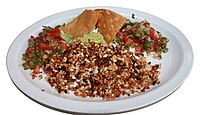You can help expand this article with text translated from
the corresponding article in Spanish. (January 2021) Click [show] for important translation instructions.
|
 Escamoles cooked in butter | |
| Alternative names | Mexican caviar |
|---|---|
| Place of origin | Mexico |
| Main ingredients | larvae and pupae of ants |
Escamoles (Spanish: [eskaˈmoles] ⓘ; Nahuatl languages: azcamolli, [1] from azcatl 'ant' and molli 'puree' [2]), known colloquially as Mexican caviar or insect caviar, are the edible larvae and pupae of ants of the species Liometopum apiculatum and L. occidentale var. luctuosum. [3] They are most commonly consumed in Mexico City and surrounding areas. [4] Escamoles have been consumed in Mexico since the age of the Aztecs. [5] [6] The taste is described as buttery and nutty, with a texture akin to that of cottage cheese. [7]
-
Escamoles al mojo de ajo
See also
- Ant eggs -the eggs and pupae of weaver ants ( Oecophylla smaragdina), eaten in several countries across Southeast Asia
- Chahuis — the edible beetles of Mexico
- Entomophagy in humans — the human consumption of insects as food
- List of delicacies
References
- ^ Reyes Castillo; Pedro Montes de Oca; Enrique Montes de Oca (1997). "Fauna". In Enrique Florescano (ed.). El patrimonio nacional de Mexico (in Spanish). Vol. I. Fondo De Cultura Economica USA. pp. 179–180. ISBN 978-968-16-5452-8.
- ^ Émile Bergier (1953). Peuples entomophages et insectes comestibles: Étude sur les moeurs de l'homme et de l'insecte (in French). N. Boubée. p. 152.
- ^ DeFoliart, Gene R. (2009). "Insects as food". In Vincent H. Resh; Ring T. Cardé (eds.). Encyclopedia of Insects. Academic Press. p. 381. ISBN 978-0-08-092090-0.
- ^ Gaso, M.I.; et al. (2003). "Biological monitoring of radioactivity and metal pollution in edible eggs of Liometopum apiculatum (ants) from a radioactive waste site in central Mexico". In Peter Warwick (ed.). Environmental Radiochemical Analysis II. Royal Society of Chemistry. pp. 334–335. ISBN 978-0-85404-618-8.
- ^ Anthony DePalma (2001). Here: A Biography of the New American Continent. PublicAffairs. p. 268. ISBN 978-1-891620-83-6.
- ^ Ramos-Elorduy, Julieta; Moreno, José Manuel Pino (2003). "El consumo de insectos entre los aztecas". In Janet Long (ed.). Conquista y comida: consecuencias del encuentro de dos mundos (in Spanish). Universidad Nacional Autónoma de México. pp. 89–90, 94. ISBN 978-970-32-0852-4.
- ^ Cox, Lauren (May 4, 2010). "Top 5 Disgusting Delicacies". ABC News. Retrieved August 19, 2014.
External links
- Club 700 Hoy video on the harvest of escamoles (in Spanish)
- Julieta Ramos-Elorduy (1998). Creepy Crawly Cuisine: The Gourmet Guide to Edible Insects. Inner Traditions – Bear & Company. pp. 105–110. ISBN 978-0-89281-747-4. (Several recipes for escamoles.)
You can help expand this article with text translated from
the corresponding article in Spanish. (January 2021) Click [show] for important translation instructions.
|
 Escamoles cooked in butter | |
| Alternative names | Mexican caviar |
|---|---|
| Place of origin | Mexico |
| Main ingredients | larvae and pupae of ants |
Escamoles (Spanish: [eskaˈmoles] ⓘ; Nahuatl languages: azcamolli, [1] from azcatl 'ant' and molli 'puree' [2]), known colloquially as Mexican caviar or insect caviar, are the edible larvae and pupae of ants of the species Liometopum apiculatum and L. occidentale var. luctuosum. [3] They are most commonly consumed in Mexico City and surrounding areas. [4] Escamoles have been consumed in Mexico since the age of the Aztecs. [5] [6] The taste is described as buttery and nutty, with a texture akin to that of cottage cheese. [7]
-
Escamoles al mojo de ajo
See also
- Ant eggs -the eggs and pupae of weaver ants ( Oecophylla smaragdina), eaten in several countries across Southeast Asia
- Chahuis — the edible beetles of Mexico
- Entomophagy in humans — the human consumption of insects as food
- List of delicacies
References
- ^ Reyes Castillo; Pedro Montes de Oca; Enrique Montes de Oca (1997). "Fauna". In Enrique Florescano (ed.). El patrimonio nacional de Mexico (in Spanish). Vol. I. Fondo De Cultura Economica USA. pp. 179–180. ISBN 978-968-16-5452-8.
- ^ Émile Bergier (1953). Peuples entomophages et insectes comestibles: Étude sur les moeurs de l'homme et de l'insecte (in French). N. Boubée. p. 152.
- ^ DeFoliart, Gene R. (2009). "Insects as food". In Vincent H. Resh; Ring T. Cardé (eds.). Encyclopedia of Insects. Academic Press. p. 381. ISBN 978-0-08-092090-0.
- ^ Gaso, M.I.; et al. (2003). "Biological monitoring of radioactivity and metal pollution in edible eggs of Liometopum apiculatum (ants) from a radioactive waste site in central Mexico". In Peter Warwick (ed.). Environmental Radiochemical Analysis II. Royal Society of Chemistry. pp. 334–335. ISBN 978-0-85404-618-8.
- ^ Anthony DePalma (2001). Here: A Biography of the New American Continent. PublicAffairs. p. 268. ISBN 978-1-891620-83-6.
- ^ Ramos-Elorduy, Julieta; Moreno, José Manuel Pino (2003). "El consumo de insectos entre los aztecas". In Janet Long (ed.). Conquista y comida: consecuencias del encuentro de dos mundos (in Spanish). Universidad Nacional Autónoma de México. pp. 89–90, 94. ISBN 978-970-32-0852-4.
- ^ Cox, Lauren (May 4, 2010). "Top 5 Disgusting Delicacies". ABC News. Retrieved August 19, 2014.
External links
- Club 700 Hoy video on the harvest of escamoles (in Spanish)
- Julieta Ramos-Elorduy (1998). Creepy Crawly Cuisine: The Gourmet Guide to Edible Insects. Inner Traditions – Bear & Company. pp. 105–110. ISBN 978-0-89281-747-4. (Several recipes for escamoles.)













